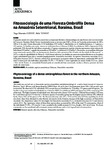Please use this identifier to cite or link to this item:
http://www.alice.cnptia.embrapa.br/alice/handle/doc/978261| Title: | Fitossociologia de uma Floresta Ombrófila Densa na Amazônia Setentrional, Roraima, Brasil. |
| Authors: | CONDÉ, T. M.  TONINI, H.   |
| Affiliation: | Tiago Monteiro Condé, UERR; HELIO TONINI, CPAMT. |
| Date Issued: | 2013 |
| Citation: | Acta Amazonica, Manaus , v. 43, n. 3, p. 247-260, Set. 2013 |
| Pages: | 247-260 |
| Description: | O presente estudo teve como objetivo caracterizar a composição florística e fitossociológica de uma floresta nativa no município de Caracaraí, Roraima, Brasil. Foram inventariadas todas as árvores com DAP >10 cm em 9 parcelas permanentes de 100 x 100 m (1 ha cada). Foram observados 4.724 indivíduos (525 ind.ha-1), distribuídos em 42 famílias botânicas, 111 gêneros e 165 espécies. As famílias com maior número de indivíduos foram Fabaceae (1.883), Lecythidaceae (609) e Sapotaceae (434), perfazendo 52% do total de indivíduos amostrados. O grupo composto por espécies pioneiras apresentou maior número de indivíduos (219 ind.ha-1), seguido das secundárias (193 ind.ha-1) e climácicas (113 ind.ha-1). No entanto, as secundárias obtiveram maior número de espécies (95), em detrimento de climácicas (44) e pioneiras (26). O índice de diversidade de Shannon (H? = 3,27) e o valor de equabilidade de Pielou (J = 0,64) foram inferiores aos obtidos em outros inventários florísticos na Amazônia Legal, contribuindo para isso o tamanho populacional de Pentaclethra macroloba. As espécies Pentaclethra macroloba (52,1), Eschweilera bracteosa (23,7) e Pouteria caimito(8,1) apresentaram os maiores valores de importância, perfazendo 28% do VI total. A maior parte dos indivíduos amostrados (71,3% = 374 ind.ha-1) foram registrados no estrato médio (12,4 m <altura < 26,5 m) da floresta. A comunidade florestal pode ser considerada bem estruturada, madura e diversa, portanto em bom estado de conservação. This study was carried out to characterize species composition and phytosociology of a native forest located at Caracaraí, Roraima, Brazil. All trees with breast diameter (DBH) above 10 cm in nine 1-ha-permanent plots (100 x 100 m each) were inventoried. We observed 4,724 individuals (525 trees per hectare) distributed in 42 families, 111 genera and 165 species. The families with greater number of individuals were Fabaceae (1883), Lecythidaceae (609) and Sapotaceae (434), comprising 52% of the total. The higher densities of individuals were observed in the pioneer (219 trees ha-1), followed by secondary (193 trees ha-1) and climax species (113 trees ha-1). However, species of secondary group had the highest species richness (95), followed by the climax (44) and the pioneer (26). The Shannon diversity index (H? = 3.27) and the value of Pielou equability (J = 0.64) were lower than those obtained in other floristic inventories in the Amazon, because of the high occurrence of Pentaclethra macroloba. The importance values (VI) were higher for Pentaclethra macroloba (52.1), Eschweilera bracteosa (23.7) and Pouteria caimito (8.1). The importance values of these three species alone accounted for 28% of the total VI across species. Most of the individuals (71.3% = 374 trees ha-1) were recorded in the middle stratum (12.4 m <height < 26.5 m) of forest. The forest community can be considered well-structured, mature and diverse, and so it is in good state of conservation. |
| Thesagro: | Pentaclethra Macroloba |
| NAL Thesaurus: | Fabaceae |
| Keywords: | Espécies Amazônicas Amazon Species Floresta Ombrófila Amazônia Setentrional |
| ISSN: | 0044-5967 |
| DOI: | http://dx.doi.org/10.1590/S0044-59672013000300002 |
| Type of Material: | Artigo de periódico |
| Access: | openAccess |
| Appears in Collections: | Artigo em periódico indexado (CPAMT)  |
Files in This Item:
| File | Description | Size | Format | |
|---|---|---|---|---|
| cpamttonini004459672013.pdf | 742.38 kB | Adobe PDF |  View/Open |









